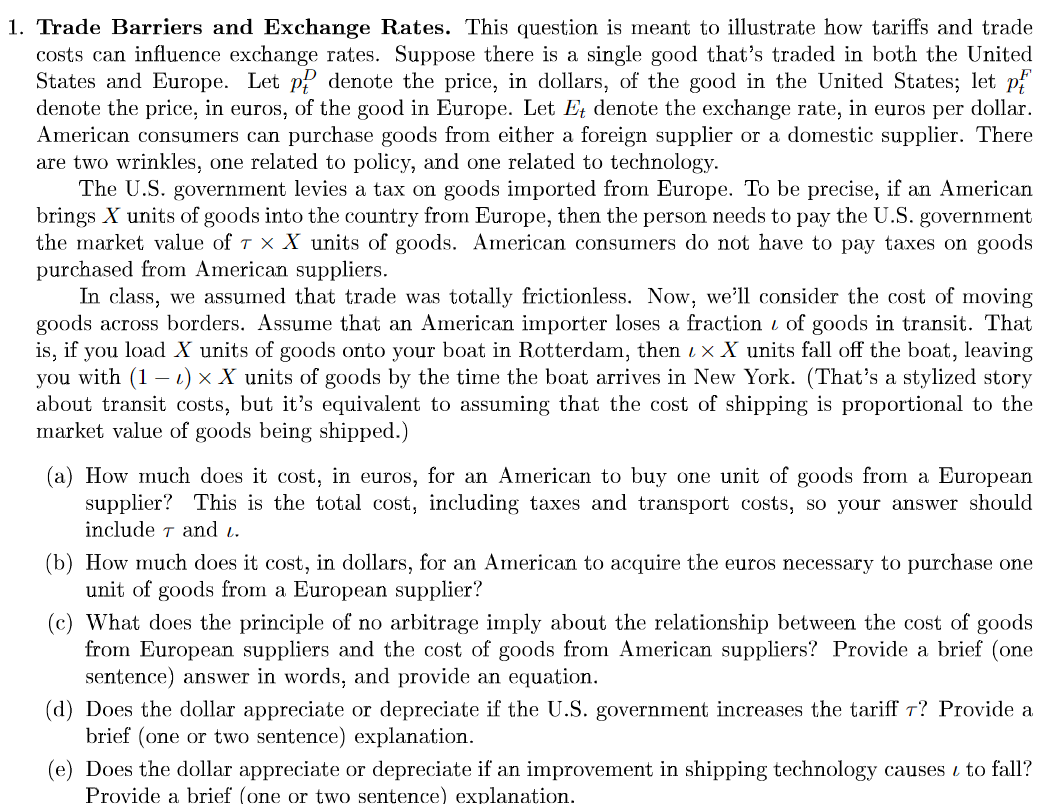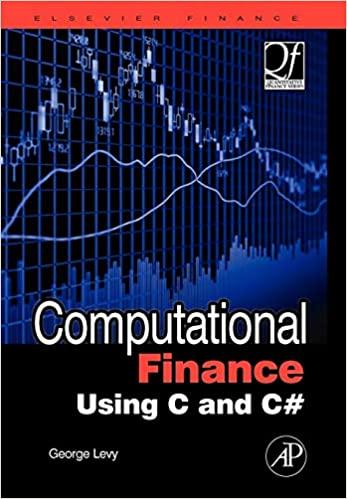Trade Barriers and exchange rates

1. Trade Barriers and Exchange Rates. This question is meant to illustrate how tariffs and trade costs can influence exchange rates. Suppose there is a single good that's traded in both the United States and Europe. Let p denote the price, in dollars, of the good in the United States; let p denote the price, in euros, of the good in Europe. Let Et denote the exchange rate, in euros per dollar. American consumers can purchase goods from either a foreign supplier or a domestic supplier. There are two wrinkles, one related to policy, and one related to technology. The U.S. government levies a tax on goods imported from Europe. To be precise, if an American brings X units of goods into the country from Europe, then the person needs to pay the U.S. government the market value of T x X units of goods. American consumers do not have to pay taxes on goods purchased from American suppliers. In class, we assumed that trade was totally frictionless. Now, we'll consider the cost of moving goods across borders. Assume that an American importer loses a fraction i of goods in transit. That you load X units of goods onto your boat in Rotterdam, then i x X units fall off the boat, leaving if is, you with (1 about transit costs, but it's equivalent to assuming that the cost of shipping is proportional to the market value of goods being shipped.) 1) X units of goods by the time the boat arrives in New York. (That's a stylized story (a) How much does it cost, in euros, for an American to buy one unit of goods from a European supplier? This is the total cost, including taxes and transport costs, so your answer should include T and i. (b) How much does it cost, in dollars, for an American to acquire the euros necessary to purchase one unit of goods from a European supplier? (c) What does the principle of no arbitrage imply about the relationship between the cost of goods from European suppliers and the cost of goods from American suppliers? Provide a brief (one sentence) answer in words, and provide an equation. (d) Does the dollar appreciate or depreciate if the U.S. government increases the tariff t? Provide a brief (one or two sentence) explanation. (e) Does the dollar appreciate or depreciate if an improvement in shipping technology causes i to fall? Provide a brief (one or two sentence) explanation. 1. Trade Barriers and Exchange Rates. This question is meant to illustrate how tariffs and trade costs can influence exchange rates. Suppose there is a single good that's traded in both the United States and Europe. Let p denote the price, in dollars, of the good in the United States; let p denote the price, in euros, of the good in Europe. Let Et denote the exchange rate, in euros per dollar. American consumers can purchase goods from either a foreign supplier or a domestic supplier. There are two wrinkles, one related to policy, and one related to technology. The U.S. government levies a tax on goods imported from Europe. To be precise, if an American brings X units of goods into the country from Europe, then the person needs to pay the U.S. government the market value of T x X units of goods. American consumers do not have to pay taxes on goods purchased from American suppliers. In class, we assumed that trade was totally frictionless. Now, we'll consider the cost of moving goods across borders. Assume that an American importer loses a fraction i of goods in transit. That you load X units of goods onto your boat in Rotterdam, then i x X units fall off the boat, leaving if is, you with (1 about transit costs, but it's equivalent to assuming that the cost of shipping is proportional to the market value of goods being shipped.) 1) X units of goods by the time the boat arrives in New York. (That's a stylized story (a) How much does it cost, in euros, for an American to buy one unit of goods from a European supplier? This is the total cost, including taxes and transport costs, so your answer should include T and i. (b) How much does it cost, in dollars, for an American to acquire the euros necessary to purchase one unit of goods from a European supplier? (c) What does the principle of no arbitrage imply about the relationship between the cost of goods from European suppliers and the cost of goods from American suppliers? Provide a brief (one sentence) answer in words, and provide an equation. (d) Does the dollar appreciate or depreciate if the U.S. government increases the tariff t? Provide a brief (one or two sentence) explanation. (e) Does the dollar appreciate or depreciate if an improvement in shipping technology causes i to fall? Provide a brief (one or two sentence) explanation







